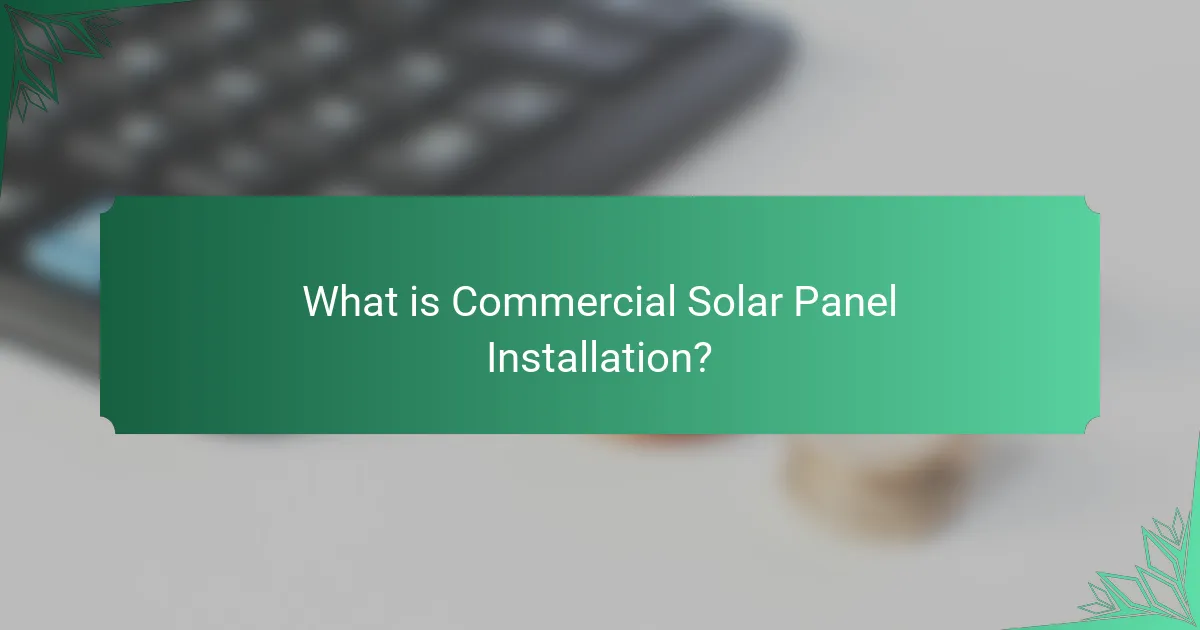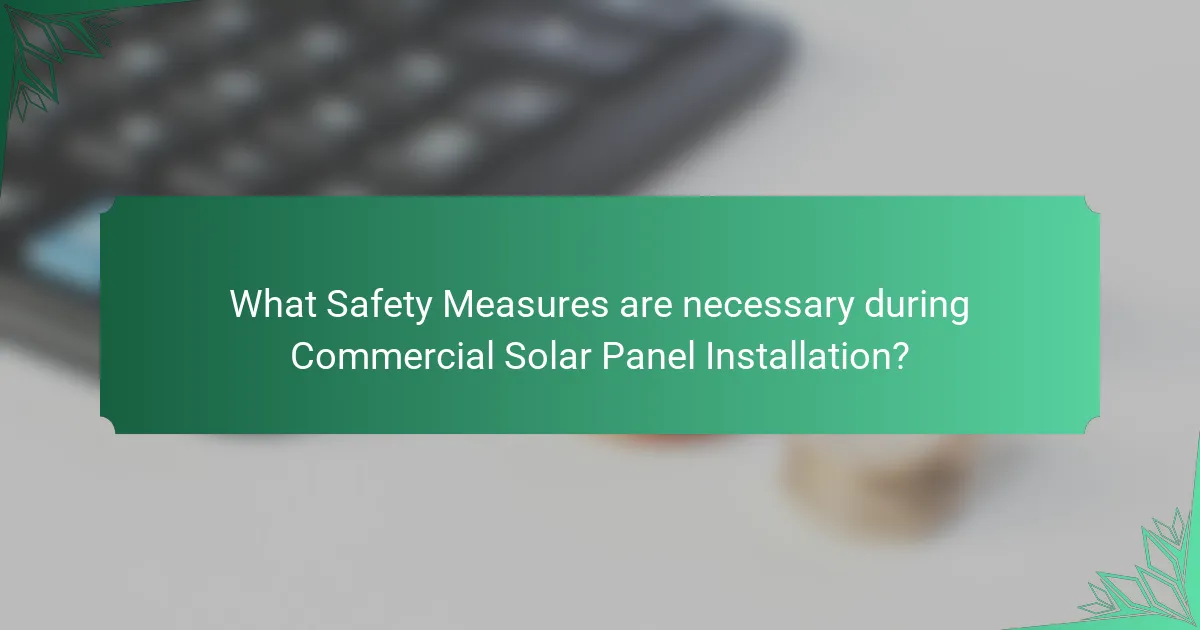
What is Commercial Solar Panel Installation?
Commercial solar panel installation refers to the process of setting up solar energy systems for businesses and commercial properties. This installation involves the mounting of solar panels on rooftops or ground-mounted systems to harness solar energy. The primary goal is to generate electricity that can be used to power the business, reducing reliance on grid energy. Typically, these systems are designed to meet the energy needs of larger facilities, often producing significant amounts of power. According to the Solar Energy Industries Association, commercial solar installations have increased by over 20% annually in recent years, highlighting their growing popularity. The installation process includes site assessment, system design, permitting, and actual installation of solar panels and inverters.
How does Commercial Solar Panel Installation work?
Commercial solar panel installation involves several key steps. First, a site assessment is conducted to evaluate the roof’s suitability. This includes checking structural integrity and shading issues. Next, a design plan is created based on energy needs and available space. The installation process begins with mounting the solar panels on the roof or ground. After mounting, the panels are connected to an inverter. The inverter converts the solar energy into usable electricity. Finally, the system is connected to the electrical grid or battery storage. According to the Solar Energy Industries Association, commercial solar installations have increased by over 20% annually in recent years, highlighting the growing adoption of this technology.
What are the key components of a commercial solar panel system?
A commercial solar panel system consists of several key components. These include solar panels, inverters, mounting systems, and electrical wiring. Solar panels convert sunlight into electricity. Inverters convert the direct current (DC) produced by the panels into alternating current (AC) for use in commercial applications. Mounting systems secure the solar panels to rooftops or ground installations. Electrical wiring connects all components and facilitates the flow of electricity. Together, these components enable the efficient operation of a commercial solar energy system.
How is energy generated through solar panels?
Energy is generated through solar panels by converting sunlight into electricity. Solar panels consist of photovoltaic (PV) cells that absorb photons from sunlight. When sunlight hits these cells, it excites electrons, creating an electric current. This process is known as the photovoltaic effect. The generated direct current (DC) is then converted into alternating current (AC) using an inverter. AC electricity is suitable for use in homes and businesses. According to the U.S. Department of Energy, solar energy can reduce electricity costs significantly. Solar panels can produce energy even on cloudy days, though efficiency may vary.
What are the benefits of Commercial Solar Panel Installation?
Commercial solar panel installation offers significant benefits for businesses. It reduces electricity costs by generating renewable energy on-site. Businesses can save up to 75% on their energy bills with solar panels. Additionally, solar installations can increase property value. Properties with solar energy systems often sell for more. Companies can also benefit from tax incentives and rebates. These financial incentives can offset installation costs significantly. Furthermore, using solar energy enhances a business’s sustainability profile. This commitment to renewable energy can attract eco-conscious consumers. Overall, commercial solar panel installation provides economic and environmental advantages.
How does Commercial Solar Panel Installation impact energy costs?
Commercial solar panel installation reduces energy costs significantly. Businesses can lower their electricity bills by generating their own power. This self-sufficiency reduces reliance on grid electricity. According to the Solar Energy Industries Association, commercial solar can save businesses 20% to 50% on energy costs. Additionally, solar installations can provide tax incentives and rebates. These financial benefits further offset the initial installation costs. Over time, the savings from reduced energy bills can lead to a return on investment within 3 to 7 years. Thus, commercial solar panel installation effectively lowers overall energy expenses.
What environmental advantages does Commercial Solar Panel Installation provide?
Commercial solar panel installation provides significant environmental advantages. It reduces greenhouse gas emissions by decreasing reliance on fossil fuels. According to the U.S. Environmental Protection Agency, solar energy can offset over 90 million metric tons of carbon dioxide annually. Solar panels also conserve water, as they require minimal water for operation compared to traditional power plants. Additionally, solar energy contributes to cleaner air by reducing pollutants associated with energy production. The installation of solar panels can lead to habitat preservation by minimizing land degradation. Overall, commercial solar panel installation promotes sustainability and environmental health.

What are the Best Practices for Commercial Solar Panel Installation?
The best practices for commercial solar panel installation include proper site assessment, adherence to local regulations, and using high-quality materials. Conducting a thorough site assessment ensures optimal placement for maximum sunlight exposure. Compliance with local regulations guarantees safety and legal standards are met. High-quality materials enhance system performance and longevity. Additionally, engaging experienced professionals for installation reduces the risk of errors. Regular maintenance and monitoring of the solar system optimize energy production. Training staff on safety protocols during installation is crucial to prevent accidents. Following these best practices can lead to efficient and safe solar panel installations in commercial settings.
How can businesses ensure optimal solar panel placement?
Businesses can ensure optimal solar panel placement by conducting a thorough site assessment. This includes evaluating roof orientation and angle. South-facing roofs typically receive the most sunlight. Businesses should also consider shading from nearby trees or buildings. An analysis of local weather patterns can help determine energy production. Utilizing software tools for solar design can enhance placement accuracy. Engaging with professional solar installers ensures compliance with regulations. Proper installation maximizes efficiency and performance. Studies show well-placed panels can increase energy output by up to 30%.
What factors should be considered for site assessment?
Factors for site assessment in commercial solar panel installation include location, shading, roof condition, and structural integrity. The location affects sunlight exposure and energy production. Shading from trees or buildings can significantly reduce efficiency. The roof condition must be assessed for durability and suitability for solar panels. Structural integrity ensures the roof can support the weight of the solar system. Additionally, local regulations and permits must be considered to comply with legal requirements. Access for installation and maintenance is also crucial for long-term operation. Finally, the orientation and tilt of the roof influence the overall energy output.
How does orientation and tilt affect solar panel efficiency?
Orientation and tilt significantly impact solar panel efficiency. Proper orientation maximizes sunlight exposure throughout the day. For optimal performance, solar panels should face true south in the Northern Hemisphere and true north in the Southern Hemisphere. The tilt angle should ideally match the latitude of the installation site. This alignment increases energy capture by allowing panels to absorb sunlight at a perpendicular angle. Studies show that a 1-degree increase in tilt can improve efficiency by about 1%. Additionally, panels tilted at 30 to 45 degrees generally yield the highest energy production. This information confirms that both orientation and tilt are critical for maximizing solar energy output.
What maintenance practices are essential for solar panels?
Regular cleaning is essential for solar panels to maintain efficiency. Dirt, dust, and debris can accumulate on the surface. This buildup can reduce sunlight absorption and impact energy production. Cleaning should be performed at least twice a year, or more frequently in dusty areas. Use a soft brush or sponge with water to avoid scratching the panels. Additionally, inspecting the panels for damage is crucial. Look for cracks or loose connections that could affect performance. Monitoring energy output helps identify any issues early. Keeping vegetation trimmed around the panels prevents shading. Lastly, professional inspections can ensure optimal functionality and safety.
How often should solar panels be cleaned and inspected?
Solar panels should be cleaned and inspected at least twice a year. Regular cleaning removes dirt and debris that can block sunlight. Inspections are essential to identify any damage or inefficiencies. Factors like local weather and surrounding vegetation can affect the frequency. In areas with heavy dust or pollen, more frequent cleaning may be necessary. Additionally, inspections should be conducted after severe weather events. This ensures optimal performance and longevity of the solar panels. Regular maintenance can increase energy output by up to 20%.
What common issues should be addressed during maintenance?
Common issues that should be addressed during maintenance of commercial solar panels include dirt accumulation, damaged panels, and inverter performance. Dirt accumulation can significantly reduce energy efficiency by blocking sunlight. Regular cleaning schedules help maintain optimal performance. Damaged panels may result from weather events or physical impacts. Inspecting panels for cracks or breaks ensures system integrity. Inverter performance is crucial for energy conversion efficiency. Monitoring inverter output can identify potential issues early. Additionally, electrical connections should be checked to prevent power losses. Regular maintenance checks can extend the lifespan of the solar system and enhance energy production.

What Safety Measures are necessary during Commercial Solar Panel Installation?
Safety measures during commercial solar panel installation include using personal protective equipment (PPE). Workers must wear helmets, gloves, and safety glasses to prevent injuries. Proper training on electrical hazards is essential. Workers should understand the risks associated with high-voltage systems. Fall protection systems must be in place when working at heights. This includes harnesses and guardrails. Additionally, securing the worksite is crucial to prevent unauthorized access. Emergency response plans should be established and communicated to all team members. These measures significantly reduce the risk of accidents and injuries during installation.
What safety protocols should installers follow?
Installers should follow several safety protocols during commercial solar panel installation. First, they must wear appropriate personal protective equipment (PPE) such as hard hats, gloves, and safety glasses. This protects against potential hazards on-site. Second, installers should conduct a thorough site assessment before beginning work. This assessment identifies any risks, such as overhead power lines or unstable surfaces.
Third, they must use proper ladder and scaffolding techniques. Installers should ensure that ladders are stable and scaffolding is correctly assembled to prevent falls. Fourth, electrical safety protocols are essential. This includes de-energizing circuits and using insulated tools when working with electrical components.
Fifth, installers should follow manufacturer guidelines for equipment handling and installation. These guidelines provide specific safety instructions relevant to the solar panels being installed. Lastly, maintaining clear communication among team members helps ensure that everyone is aware of safety procedures and potential hazards. Following these protocols significantly reduces the risk of accidents and injuries during installation.
How can electrical hazards be minimized during installation?
Electrical hazards can be minimized during installation by following strict safety protocols. First, always de-energize electrical circuits before beginning work. This prevents accidental shocks. Use insulated tools to protect against electrical contact. Personal protective equipment, such as gloves and safety glasses, should be worn at all times. Proper grounding of equipment is essential to avoid electrical faults. Additionally, ensure that all wiring is installed according to local codes and regulations. Regular training on electrical safety practices can enhance awareness among workers. Finally, conducting thorough inspections of the installation site can identify potential hazards before work begins.
What personal protective equipment (PPE) is required?
Personal protective equipment (PPE) required for commercial solar panel installation includes safety helmets, gloves, safety glasses, and harnesses. Safety helmets protect against head injuries from falling objects. Gloves prevent electrical hazards and cuts. Safety glasses shield the eyes from debris and UV radiation. Harnesses are essential for fall protection when working at heights. According to OSHA regulations, proper PPE reduces the risk of injury on construction sites.
How can businesses ensure compliance with safety regulations?
Businesses can ensure compliance with safety regulations by implementing comprehensive safety management systems. These systems should include regular training for employees on safety protocols. Conducting frequent safety audits helps identify potential hazards. Additionally, businesses must stay updated on relevant regulations and industry standards. Documenting safety procedures and incidents is essential for accountability. Engaging with safety consultants can provide expert guidance tailored to specific needs. Utilizing safety equipment and protective gear is also a critical measure. Following these practices can significantly reduce the risk of accidents and ensure regulatory compliance.
What local and national codes must be adhered to?
Local and national codes for commercial solar panel installation include the National Electrical Code (NEC) and local building codes. The NEC sets standards for electrical safety in installations. Local building codes may vary by jurisdiction and often address structural integrity and zoning regulations. Compliance ensures safety and legality of the installation. Following these codes minimizes risks associated with electrical systems and structural failures. Adhering to the NEC is mandatory in the United States. Local codes can be obtained from municipal planning departments.
How can training programs enhance safety awareness among workers?
Training programs enhance safety awareness among workers by providing structured education on safety protocols. These programs teach workers about potential hazards specific to their jobs. They also cover the proper use of safety equipment and emergency procedures. Engaging training methods, such as simulations, increase retention of safety information. Regularly updated training keeps workers informed of the latest regulations and best practices. According to the Occupational Safety and Health Administration (OSHA), effective training can reduce workplace accidents by up to 29%. This statistic highlights the importance of comprehensive training in fostering a culture of safety.
What are some common troubleshooting tips for solar panel systems?
Check the inverter for error codes. This device converts solar energy into usable electricity. If it shows an error, refer to the manual for troubleshooting steps. Inspect the solar panels for dirt or debris. Clean panels can improve efficiency by up to 25%. Ensure that the panels are not shaded by trees or buildings. Shade can significantly reduce energy output. Verify all connections for tightness and corrosion. Loose or corroded connections can lead to system failures. Monitor the energy output regularly. Compare it with expected performance based on sunlight hours. If there are discrepancies, further investigation is needed. Finally, consult a professional if issues persist. Professional technicians can diagnose complex problems accurately.
Commercial solar panel installation involves setting up solar energy systems for businesses, aimed at reducing reliance on grid energy and generating significant electricity. The article covers the installation process, key components of solar systems, and the energy generation mechanism, emphasizing the economic and environmental benefits. It also outlines best practices for optimal installation, including site assessment and maintenance, while highlighting essential safety measures and compliance with local and national codes. Troubleshooting tips for solar panel systems are provided to ensure efficient operation and address common issues.